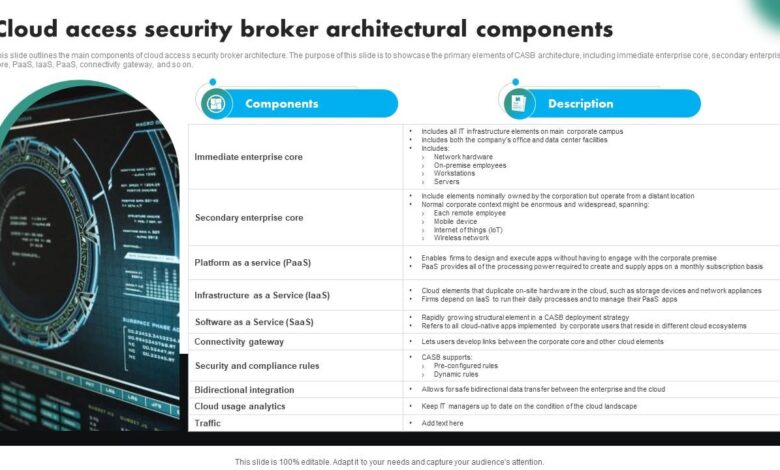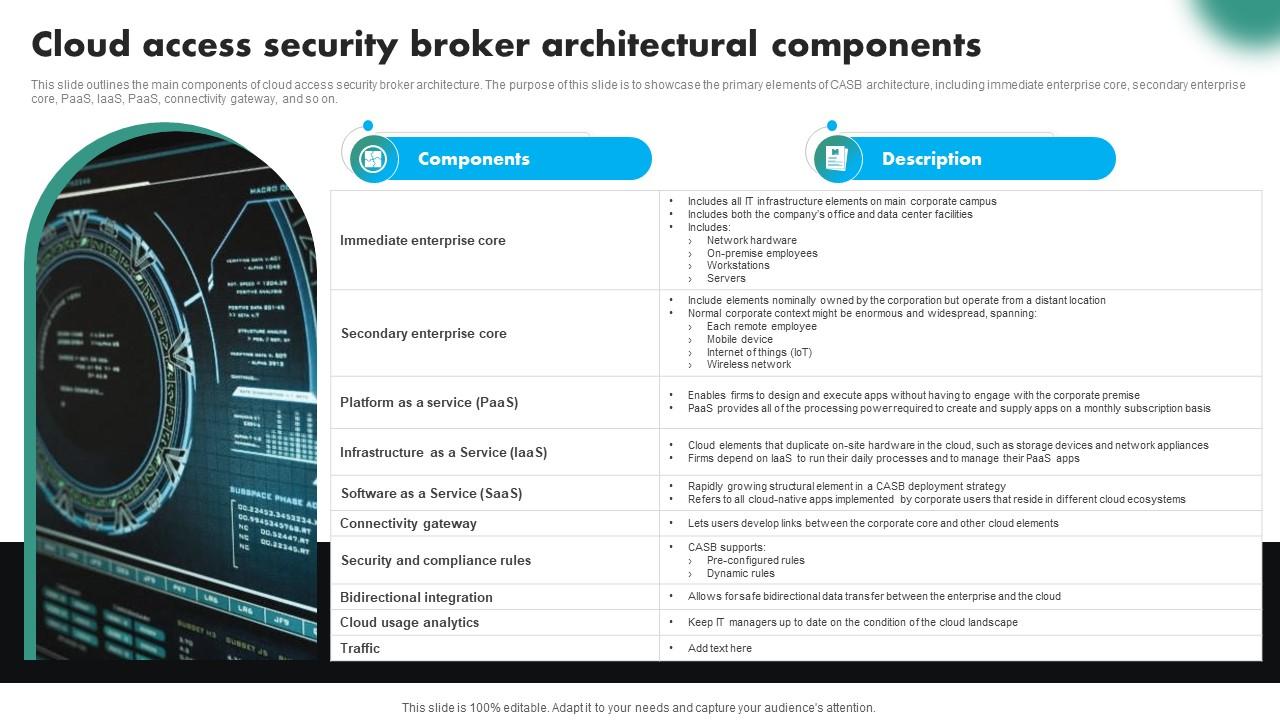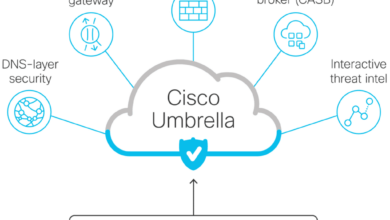
Cloud Access Security Brokers Not Enough
Cloud Access Security Brokers Not Enough: We all know cloud security is crucial, and CASBs have become a staple in many organizations’ security strategies. But are they truly enough to keep our precious data safe in today’s ever-evolving threat landscape? This post dives deep into the limitations of CASBs and explores why a more comprehensive approach is absolutely necessary.
From the subtle ways attackers bypass CASB controls to the critical data loss prevention gaps they leave wide open, we’ll unpack the reality of relying solely on CASBs. We’ll examine how a Zero Trust architecture can bridge these gaps and discuss the essential role of other security tools in creating a robust, layered defense system for your cloud environment.
Get ready for a realistic look at the future of cloud security – it’s a lot more than just CASBs.
Limitations of Cloud Access Security Brokers (CASB)
Cloud Access Security Brokers (CASBs) have become a cornerstone of many organizations’ cloud security strategies, offering a layer of protection between users and cloud applications. However, relying solely on a CASB for comprehensive cloud security is a risky proposition. While they provide valuable functionality, CASBs possess inherent limitations that can leave organizations vulnerable to sophisticated attacks. Understanding these limitations is crucial for building a robust and multi-layered security posture.
CASB Architectural Limitations
CASBs typically operate using one of two primary architectures: a forward proxy or an API-based approach. Forward proxies intercept traffic destined for cloud applications, inspecting it for threats before forwarding it. API-based CASBs leverage the cloud provider’s APIs to monitor and control access. Both approaches have limitations. Forward proxies can introduce latency and complexity, especially with large amounts of traffic.
API-based solutions are limited by the data exposed through the APIs, potentially missing threats outside of the API’s scope. Furthermore, both methods struggle to effectively protect against threats originating from within the cloud environment itself, such as insider threats or compromised cloud instances.
Attack Vectors Bypassing CASB Controls
Several attack vectors can effectively bypass or circumvent CASB controls. For example, attackers might leverage compromised credentials to gain unauthorized access, exploiting vulnerabilities in the cloud application itself, or employing techniques like data exfiltration through unmonitored channels (e.g., personal email, USB drives). Sophisticated attackers can also utilize techniques such as advanced persistent threats (APTs) which can often evade detection by traditional security tools, including CASBs.
Furthermore, CASBs often struggle with encrypted traffic, limiting their visibility into the data being transmitted.
Cloud Security Threats Unmitigated by CASB
CASBs are not a panacea for all cloud security threats. They struggle to effectively mitigate threats such as: advanced persistent threats (APTs), zero-day exploits, insider threats, misconfigurations of cloud resources (e.g., improperly configured storage buckets), and vulnerabilities within the cloud provider’s infrastructure. While a CASB can identify suspicious activity, it often lacks the contextual awareness to differentiate between legitimate and malicious actions, leading to false positives or missed threats.
The inherent limitations of a CASB are often exacerbated by the increasing complexity of cloud environments and the rapid evolution of attack techniques.
Comparison with Other Cloud Security Solutions
CASBs are just one piece of the cloud security puzzle. Other solutions, such as Cloud Security Posture Management (CSPM) tools, Cloud Workload Protection Platforms (CWPPs), and Security Information and Event Management (SIEM) systems, offer complementary capabilities. CSPM tools focus on configuration and compliance, identifying misconfigurations that could expose sensitive data. CWPPs provide runtime protection for workloads running in the cloud.
SIEM systems collect and analyze security logs from various sources, providing a centralized view of security events. A robust cloud security strategy relies on the integration and orchestration of these various solutions, not just a CASB alone.
Hypothetical Scenario Demonstrating CASB Insufficiency
Imagine a scenario where an employee, already compromised by a phishing attack, uses their legitimate credentials to access a cloud storage service. The CASB might detect unusual activity, such as a large data transfer. However, if the data is encrypted, the CASB may not be able to determine if it is malicious. The employee then uses a personal email account to exfiltrate the data, bypassing the CASB’s monitoring of sanctioned applications.
This scenario highlights the limitations of a CASB operating in isolation. A comprehensive solution would require additional layers of security, such as endpoint detection and response (EDR), data loss prevention (DLP), and a robust incident response plan.
Data Loss Prevention (DLP) Gaps with CASB

While Cloud Access Security Brokers (CASBs) offer a valuable layer of security for cloud applications, they aren’t a silver bullet for data loss prevention (DLP). Their effectiveness is often hampered by several inherent limitations, creating gaps that sophisticated attackers can exploit. Understanding these limitations is crucial for building a comprehensive DLP strategy.
Data Classification Challenges and their Impact on CASB Effectiveness
Effective DLP hinges on accurate data classification. CASBs rely on predefined policies and rules to identify sensitive data based on s, data types, or location. However, the complexity of modern data, coupled with the diverse ways data is stored and shared, makes comprehensive classification extremely challenging. For example, a CASB might flag a document containing the word “confidential,” but fail to recognize the same information embedded within an image or disguised through steganography.
Furthermore, constantly evolving data formats and the proliferation of unstructured data make creating truly effective classification rules an ongoing battle. Inaccurate classification leads to either false positives (legitimate data being blocked) or, more critically, false negatives (sensitive data slipping through undetected). This directly impacts the CASB’s ability to effectively prevent data loss.
Examples of Data Breaches Where CASB Failed to Prevent Data Loss
Several high-profile data breaches highlight the limitations of CASBs in preventing data loss. While specific details are often confidential, many cases illustrate the failure of CASBs to identify and block data exfiltration through less common channels. For instance, a breach might involve an insider using a personal device to transfer data outside the organization’s purview, circumventing the CASB’s monitoring of corporate-owned devices and applications.
Another scenario could involve an attacker exploiting a zero-day vulnerability in a cloud application, bypassing the CASB’s security controls entirely. The failure in these instances often stems from a combination of factors, including insufficient data classification, inadequate policy enforcement, and the emergence of novel attack vectors.
The Role of User Behavior in Data Exfiltration
Human error and malicious insider threats remain significant contributors to data breaches, regardless of the security technologies deployed. CASBs can monitor user activity and flag suspicious behavior, such as unusually large downloads or attempts to access sensitive data outside of normal working hours. However, a sophisticated user can often circumvent these controls through social engineering techniques or by exploiting vulnerabilities in the CASB itself.
For example, a malicious insider might use a personal email account to send sensitive data, bypassing the CASB’s monitoring of corporate email. Similarly, a user might cleverly obfuscate sensitive data to avoid detection by -based DLP rules. Therefore, a strong security posture necessitates a combination of technical controls, like CASBs, and robust security awareness training for users.
Comparison of DLP Strategies and CASB Integration
| DLP Strategy | Description | CASB Integration | Strengths |
|---|---|---|---|
| -based DLP | Identifies sensitive data based on s or patterns. | Often integrated directly into CASB policies. | Simple to implement, good for basic protection. |
| Data Loss Prevention (DLP) Tools | Standalone solutions offering more comprehensive data discovery, classification, and monitoring capabilities. | Can be integrated with CASBs to provide a more robust DLP solution. | More advanced features like data masking and encryption. |
| User and Entity Behavior Analytics (UEBA) | Analyzes user and entity behavior to detect anomalies indicative of malicious activity or data exfiltration. | Can supplement CASB’s monitoring capabilities, providing context to alerts. | Improved detection of insider threats and advanced persistent threats. |
| Data Encryption | Protects data at rest and in transit, rendering it unusable even if compromised. | Can be integrated with CASB to enforce encryption policies for sensitive data stored in the cloud. | Strongest form of data protection, preventing unauthorized access. |
Zero Trust Security Model and its Relation to CASB

Cloud Access Security Brokers (CASBs) offer valuable security controls for cloud applications, but their limitations are increasingly apparent in today’s sophisticated threat landscape. A Zero Trust security model, however, provides a more comprehensive and proactive approach, addressing many of the shortcomings of CASB alone. This exploration will examine the synergy and integration challenges between these two crucial security elements.
The core principle of Zero Trust is “never trust, always verify.” This contrasts with traditional perimeter-based security, which assumes that anything inside the network is trustworthy. CASBs, while offering visibility and control over cloud app usage, inherently operate within a perimeter-based model, often trusting users once they’ve authenticated. A Zero Trust approach, conversely, verifies every user, device, and application request regardless of location, demanding continuous authentication and authorization.
CASB Limitations Addressed by Zero Trust
Zero Trust’s continuous verification directly addresses several key CASB limitations. For example, CASBs often struggle with shadow IT – unauthorized cloud applications used by employees. Zero Trust, through its micro-segmentation and granular access controls, can effectively identify and manage access to these shadow IT applications, preventing data breaches resulting from their use. Another area where Zero Trust excels is in mitigating insider threats.
Even if a legitimate user gains unauthorized access, Zero Trust’s least privilege access controls limit the damage they can inflict. A CASB might detect suspicious activity after the fact, but Zero Trust aims to prevent such activity from occurring in the first place.
Integration Challenges Between Zero Trust and CASB
Integrating Zero Trust and CASB effectively requires careful planning and execution. One major challenge lies in consolidating security policies. A Zero Trust architecture often involves numerous security tools and policies, which need to be harmonized with the CASB’s existing controls. Another hurdle is the potential for conflict between the two systems. For example, if a Zero Trust policy blocks access based on device posture, while the CASB allows access based on user identity, this can create security gaps.
Effective integration necessitates careful orchestration and automation to ensure seamless and consistent security enforcement.
Zero Trust Controls Beyond CASB Capabilities
Zero Trust incorporates several security controls that extend beyond CASB functionalities. These include strong authentication methods like multi-factor authentication (MFA) for all users and devices, regardless of network location. Zero Trust also emphasizes micro-segmentation, isolating network resources and applications to limit the impact of breaches. Furthermore, Zero Trust leverages continuous monitoring and threat detection, constantly assessing user behavior and system activity for anomalies.
These capabilities provide a layered defense strategy that enhances the protection offered by CASBs. For instance, while a CASB might detect malware within a cloud application, Zero Trust’s endpoint detection and response (EDR) solutions can prevent the malware from executing in the first place by isolating the compromised device.
Examples of Zero Trust Addressing CASB Shortcomings
Imagine a scenario where an employee uses an unauthorized cloud storage service to store sensitive company data. A CASB might detect this activity after the data has already been uploaded. A Zero Trust architecture, however, could prevent this from happening by only allowing access to approved cloud storage services, enforcing data loss prevention (DLP) policies at the endpoint level, and blocking access from unmanaged devices.
Similarly, if a user’s credentials are compromised, a CASB might only detect suspicious login attempts after the breach. Zero Trust’s continuous authentication and authorization mechanisms, including risk-based authentication and adaptive access policies, significantly reduce the window of vulnerability and limit the potential impact of a compromised account.
The Role of Other Security Tools in a Comprehensive Cloud Security Strategy
A robust cloud security posture relies on more than a single solution. While Cloud Access Security Brokers (CASBs) offer valuable control over cloud app usage and data, their effectiveness is significantly enhanced when integrated into a layered security architecture. A multi-layered approach acknowledges the inherent limitations of any single security tool and provides redundancy and overlapping protection against various threats.
This approach ensures that if one layer fails, others are in place to mitigate the risk.A layered security approach leverages multiple tools to address the diverse challenges presented by the cloud environment. CASBs, while crucial, are not a silver bullet. They often lack comprehensive visibility into specific aspects of cloud security, necessitating complementary tools to fill these gaps.
This approach creates a more resilient and adaptable security framework capable of responding to the ever-evolving threat landscape.
Cloud Security Posture Management (CSPM) Tools, Cloud access security brokers not enough
CSPM tools provide continuous monitoring and assessment of the security configuration of cloud environments. They scan for misconfigurations, vulnerabilities, and compliance violations, offering crucial insights that CASBs often lack. For example, a CSPM tool might identify a misconfigured storage bucket that exposes sensitive data, a vulnerability that a CASB, focused primarily on data traffic, might miss. These tools often integrate directly with cloud providers’ APIs, offering comprehensive visibility into the cloud infrastructure’s security posture.
This allows for proactive remediation of vulnerabilities before they can be exploited.
Intrusion Detection and Prevention Systems (IDPS)
IDPS solutions monitor network traffic and system activity for malicious behavior. In the cloud, this is crucial for detecting and preventing attacks targeting cloud infrastructure or applications. While CASBs focus on data access and usage, IDPS solutions protect the underlying infrastructure. For instance, a distributed denial-of-service (DDoS) attack targeting a web application would be mitigated by an IDPS, whereas a CASB would primarily focus on preventing unauthorized access to the application’s data.
IDPS systems can identify and block malicious traffic, protecting the cloud environment from various threats, complementing the data-centric focus of a CASB.
Security Information and Event Management (SIEM)
SIEM systems collect and analyze security logs from various sources, providing a centralized view of security events across the entire cloud environment. This includes logs from CASBs, CSPMs, IDPS, and other security tools. By correlating events from different sources, SIEM solutions can identify complex attacks and security incidents that might be missed by individual tools. For example, a SIEM system might detect a pattern of suspicious login attempts followed by unusual data access, indicating a potential breach, even if the individual events themselves appear benign.
This consolidated view enables faster incident response and more effective threat hunting.
Best Practices for Integrating Multiple Security Solutions
Implementing multiple security tools effectively requires careful planning and coordination. Here are some best practices:
- Prioritize and align security tools with specific business needs: Start by identifying the most critical risks and selecting tools that address these risks effectively. Don’t just add tools for the sake of it.
- Ensure seamless integration and data sharing: Tools should communicate with each other and share data effectively to enable comprehensive threat detection and response.
- Establish clear roles and responsibilities: Define who is responsible for managing and monitoring each security tool.
- Develop comprehensive security policies and procedures: These policies should Artikel how security tools are used and how security incidents are handled.
- Regularly test and update security tools: This ensures that the tools remain effective against evolving threats.
- Invest in skilled security personnel: Managing and maintaining a multi-layered security approach requires expertise and experience.
Advantages of a Multi-Layered Approach
A multi-layered approach offers several key advantages over relying solely on CASBs:
- Enhanced protection against a wider range of threats: Multiple tools address different attack vectors and vulnerabilities, creating a more robust defense.
- Improved visibility and threat detection: Multiple tools provide a more comprehensive view of the cloud environment, allowing for earlier detection of threats.
- Increased resilience to security failures: If one tool fails, others are in place to provide protection.
- Better compliance with security regulations: A multi-layered approach can help organizations meet compliance requirements more effectively.
- Reduced risk of data breaches: By addressing multiple vulnerabilities, a multi-layered approach reduces the likelihood of successful data breaches.
Future Trends in Cloud Security Beyond CASB
The reliance on Cloud Access Security Brokers (CASBs) as the primary defense against cloud threats is evolving. While CASBs offer valuable capabilities, their limitations in addressing the complexities of modern cloud environments are becoming increasingly apparent. The future of cloud security hinges on a more comprehensive, integrated, and proactive approach that leverages emerging technologies and methodologies.Emerging technologies and approaches are significantly enhancing cloud security, moving beyond the reactive nature of traditional CASB solutions.
These advancements focus on prevention, automation, and intelligent threat detection, leading to a more robust and adaptable security posture.
Next-Generation Secure Access Service Edge (SASE) Architectures
SASE integrates network security functions, such as Secure Web Gateway (SWG), Firewall as a Service (FWaaS), and CASB, into a cloud-delivered service. This consolidated approach simplifies security management, improves performance, and enhances visibility across distributed environments. For example, a company with offices globally could leverage SASE to consistently enforce security policies regardless of user location or network connection, eliminating the need for multiple point solutions and reducing complexity.
The inherent integration of different security services within the SASE architecture addresses some of the limitations of standalone CASB deployments, offering a more comprehensive security posture.
AI and Machine Learning in Cloud Security
AI and machine learning are transforming cloud security by enabling proactive threat detection and response. These technologies analyze vast amounts of data to identify anomalies and patterns indicative of malicious activity, significantly improving the accuracy and speed of threat detection. For instance, AI-powered systems can detect sophisticated attacks like zero-day exploits that traditional signature-based security tools often miss.
Machine learning algorithms can also be used to automate incident response, reducing the time it takes to contain and remediate security breaches. Companies like CrowdStrike are already leveraging AI and ML to provide real-time threat detection and response capabilities in cloud environments.
Serverless Security and Function-Level Protection
The rise of serverless computing presents unique security challenges. Traditional security models struggle to keep pace with the ephemeral nature of serverless functions. Emerging solutions focus on securing individual functions, providing granular control and visibility. This approach allows organizations to apply security policies at the function level, reducing the attack surface and enhancing the overall security posture.
A hypothetical example would be implementing runtime protection for each serverless function, ensuring that only authorized code is executed and preventing unauthorized access to sensitive data.
Automation and Orchestration for Enhanced Security
Automation and orchestration play a critical role in strengthening cloud security postures. By automating security tasks, organizations can improve efficiency, reduce human error, and accelerate incident response. Orchestration platforms enable the integration of various security tools and processes, creating a cohesive and responsive security system. A practical example would be automating the provisioning and configuration of security controls for new cloud resources, ensuring that security policies are consistently applied across the entire cloud environment.
This eliminates the risk of manual configuration errors and ensures that security controls are in place before new resources become operational.
A Hypothetical Future Cloud Security Landscape
In a future cloud security landscape, CASB may play a reduced, albeit still important, role. It will likely be integrated into broader security platforms like SASE, working in conjunction with AI/ML-driven threat detection and response systems, and function-level security controls. Security will be more proactive and preventative, relying less on reactive measures and more on continuous monitoring and automated remediation.
The emphasis will shift from perimeter-based security to a zero-trust model, verifying every user and device before granting access to cloud resources, regardless of location. This model, combined with the enhanced capabilities of AI/ML and automation, will provide a significantly more robust and adaptable security posture than what is currently possible with CASB alone.
End of Discussion: Cloud Access Security Brokers Not Enough
In short, while CASBs offer a valuable layer of cloud security, they’re simply not a silver bullet. The complex and ever-shifting nature of cyber threats demands a multi-faceted approach, integrating CASBs with other robust security solutions and embracing a Zero Trust mindset. Ignoring the limitations of CASBs and relying solely on them leaves your organization vulnerable. A layered, proactive, and adaptable security strategy is the key to navigating the complexities of cloud security and ensuring your data remains safe.
FAQ
What are some common attack vectors that bypass CASBs?
Attackers can use techniques like insider threats, compromised credentials, or exploiting vulnerabilities in applications or APIs to bypass CASB controls. Sophisticated attacks might leverage legitimate user accounts or exploit shadow IT to circumvent CASB monitoring.
How can AI and machine learning improve cloud security beyond CASBs?
AI and ML can enhance threat detection by analyzing vast amounts of data to identify anomalies and predict potential attacks. This allows for proactive threat mitigation and more effective response to emerging threats that CASBs might miss.
What are the key integration challenges between Zero Trust and CASB?
Integrating Zero Trust with CASB requires careful planning and coordination to ensure seamless data flow and consistent security policies. Challenges can include managing overlapping functionalities and ensuring proper authentication and authorization across different systems.
Are there any open-source alternatives to commercial CASBs?
While comprehensive, commercial-grade CASB solutions are prevalent, several open-source tools offer specific functionalities that can supplement or partially replace certain CASB features. However, they often require more technical expertise to implement and manage effectively.





